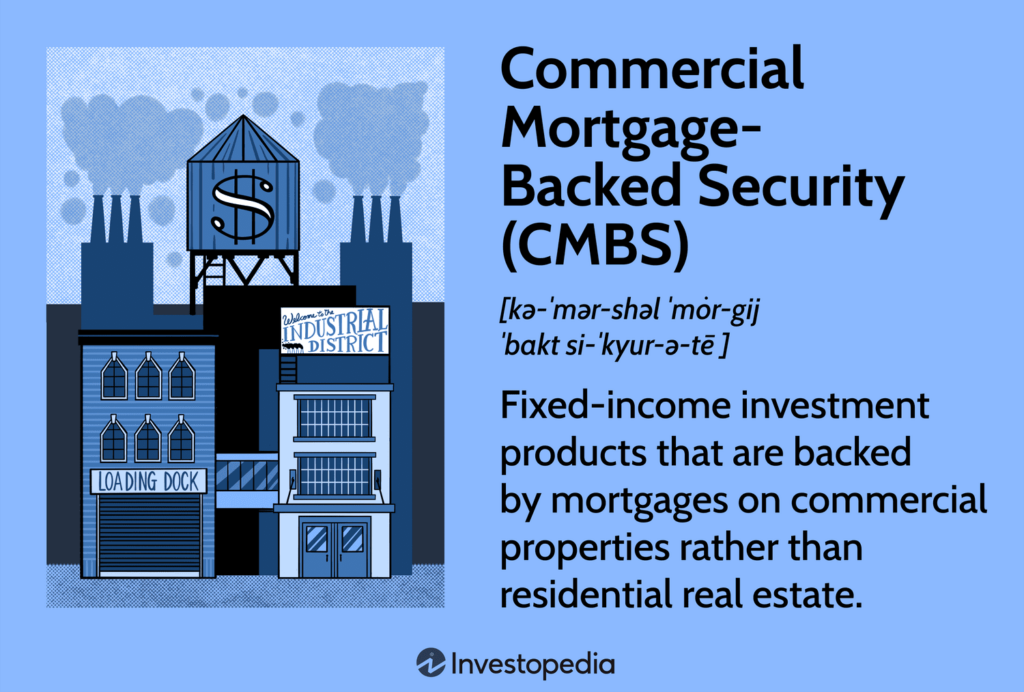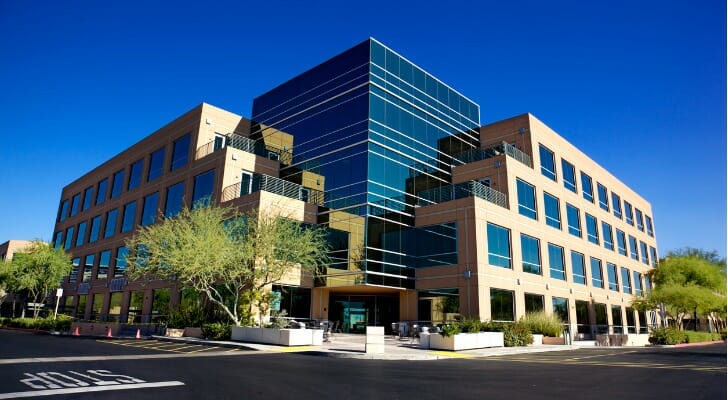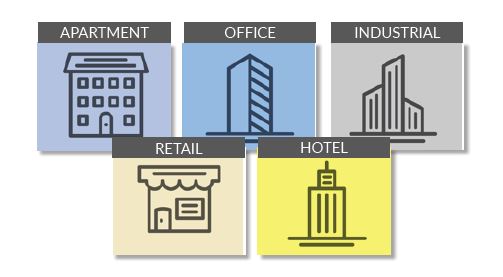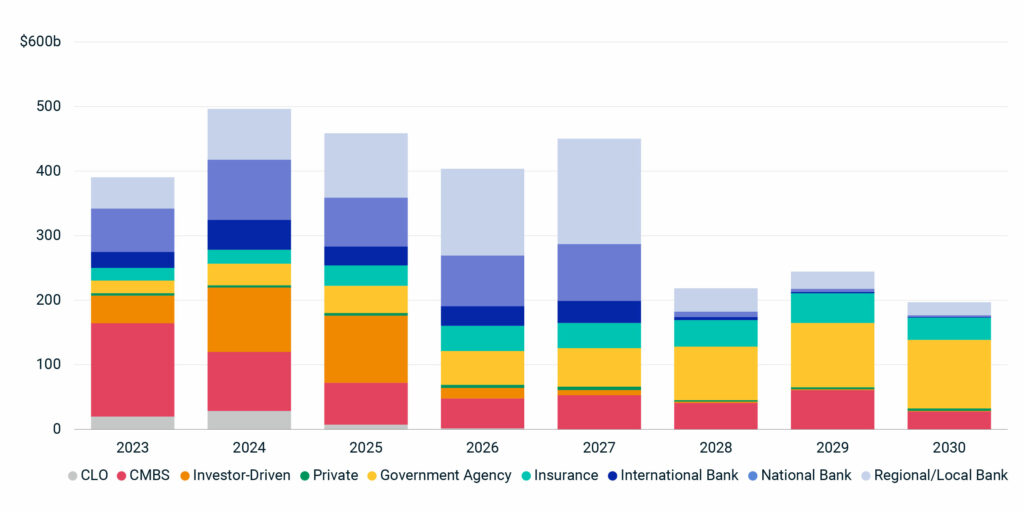Not All Commercial Real Estate Loans Are Created Equal
Not all commercial real estate loans are conventional. Commercial Mortgage-Backed Security loans (CMBS), sometimes referred to as conduit loans, are a category of commercial real estate fixed income loans that are secured by a first position mortgage on a commercial property asset. CMBS loans are typically offered by commercial banks, conduit lenders, or investment banks, and, once they are issued, they are packaged in tranches and sold to investors. Importantly, these are typically non-recourse loans and offer low interest rates and relatively high leverage, with loan-to-value requirements typically going up to 75% for eligible properties. CMBS investments are in the form of bonds with the underlying loans/notes typically held within trusts. The loans act as collateral with principal and interest passed onto investors after a default. Banks, cleverly, do not hold CMBS loans on their balance sheets so they can offer these loans to borrowers at relatively low fixed interest rates, and can also qualify borrower with relatively high leverage.

Another unique feature of CMBS loans is that they can provide liquidity to real estate investors and commercial lenders alike – simply as an equity line of credit a borrower can use at their discretion
Hard to Value CMBS Tranches
Because there are virtually no rules for standardizing the structures of CMBS by the underwriters, their valuations can be difficult to ascertain. The underlying securities of CMBS loans may include several commercial mortgages with unique terms, values, and property types—such as multi-family dwellings, office buildings, and other commercial real estate. CMBS loans can also offer less of a pre-payment risk than residential mortgage-backed securities (RMBS), as the term on commercial mortgages is generally fixed.
When a commercial or conduit lender issues a CMBS loan, they will pool or package it in tranches with a variety of other loans to create a commercial mortgage-backed security (CMBS). Remember Christian Bale in “The Big Short”? These CMBS loans can be thought of as bonds, as they are also traded on the open market. As a comparison investing standpoint, CMBS loans are often compared to residential mortgage-backed securities RMBSs, which are securities created based on residential mortgage loans.

CMBS financing can be a nice fit for projects that are not working or qualifying for government backed lenders like Fannie Mae or Freddie Mac. CMBS underwriters are more asset focused allowing lenders to be more flexible for riskier borrowers with credit or legal issues, i.e., recent bankruptcy. These loans are also sometimes ideal for situations requiring a shotgun closing process with less red tape and more focus on the property income than the borrower or the curb appeal of the multifamily project.
Mechanics of CMBS Loans – What are the Common Features of CMBS Loans?
CMBS loans are predominately fixed interest rate loans, with terms of 5-10 years (ending with a balloon payment), and amortizations of between 25 and 30 years. Importantly, CMBS loans are non-recourse (with exceptions discussed later) and assumable. In other words, in most cases, a CMBS lender is precluded from attaching a judgment against a borrower’s personal property in the case of a loan default. Because these loans are assumable the borrower, if they sold the commercial property, can pass on the CMBS loan to a new purchaser.

What Borrowers are Eligible for Conduit Loans?
Like conventional commercial real estate loans lenders look at three major factors, debt service coverage ratio (DSCR), capitalization rate, and loan-to-value (LTV) calculations, when deciding if a commercial real estate borrower is eligible for a conduit loan. LTV, is determined by dividing the loan amount by the appraised value of the commercial property. DSCR is determined by the net operating income by the total debt service of the property. Most CMBS lenders will accept properties with a maximum LTV of 75% and a DSCR of 1.25 to 1.35x. Commercial lenders also look at a property’s debt yield, determined by taking a property’s net operating income, dividing it by the loan amount, and multiplying it by 100. CMBS lenders typically prefer properties with a debt yield of 7% or more.
How Commercial Mortgage-Backed Securities (CMBS) Work
Like collateralized debt obligations (CDO) and collateralized mortgage obligations (CMO), commercial mortgage-backed securities (CMBS) are merely structured bonds. The constituent mortgage loans, forming a singular entity within a single CMBS, assume the role of collateral in the event of default, with the ensuing principal and interest distributions directed to investors.
These loans, varied in terms, property types, and amounts, are typically housed within a trust. Within this trust, a diverse array of underlying loans undergo securitization to compose the CMBS. These encompass loans associated with an array of property types, including apartment buildings and complexes, factories, hotels, office buildings, office parks, and shopping malls, often coexisting within the same trust. This intricate interplay of diversified assets contributes to the nuanced structure and resilience of commercial mortgage-backed securities.
Within the domain of real estate financing, a mortgage loan, commonly characterized as non-recourse debt, pertains to any consumer or commercial debt secured solely by collateral, i.e., the secured property. In the event of default, the lender’s recourse is confined to the collateral, precluding the seizure of any additional assets from the borrower.

Given the intricate nature of Commercial Mortgage-Backed Securities (CMBS) as sophisticated investment instruments, their effective functioning necessitates the involvement of a diverse spectrum of market participants. These stakeholders include investors, a primary servicer, a master servicer, a special servicer, a directing certificate holder, trustees, and rating agencies. Each of these entities assumes a specific and crucial role, collectively ensuring the proper performance and resilience of the CMBS within the intricate landscape of real estate investment.
Types of CMBS Tranches
The commercial mortgages that are bundled for CMBS investments are classified into tranches according to their individual levels of credit risk, which typically are ranked from senior—or highest quality—to lower quality. The most desirable highest quality tranches will receive interest and principal payments and have the lowest associated risk. Less desirable lower tranches offer higher interest rates. The higher risk tranches take on more risk and also absorb most of the potential loss that can occur as the tranches devalue.
Typical tranche hierarchy:
- Senior tranche: Senior tiers of tranches are first in line for repayment because they are less risky, and hence a safer investment of a CMBS. For this reason, they also tend to pay lower interest rates.
- Mezzanine tranche: Mezzanine tranches, or mid-level tranche, have more risk than senior tier tranches, but they also pay higher yields to make up for the increased risk. If a default occurs, these mid-tranche investors are repaid after the investors in the senior tranches.
- Equity tranche: The lowest level is the equity tranche and is the riskiest part of a commercial mortgage-backed security. To entice investment in these they are offered the highest potential return.
The lowest tranches in a CMBS structure obviously contain the riskiest—and sometimes speculative— commercial loans in the portfolio. The tranche creation process, the process designs a CMBS’s structure, is important for both banks and investors. This process allows banks to issue more loans in total, and it gives investors access to commercial real estate investments – that might not otherwise be available – also offering more yield than traditional government bonds.
Components of a CMBS
CMBS loans have several features not found in convention commercial loans. Ironically, these loans are available to a wide swath of borrowers, even those who have less than perfect credit, bankruptcies, or strict collateral/net worth requirements. Moreover, CMBS loans are mostly non-recourse, which means that if a borrower defaults on their loan, the lender usually can’t go after their personal property to repay the debt – but could go after a guarantor depending on the terms. Additionally, CMBS loans offer high leverage, at up to 75% for most property types- up to 80% in some situations.

Surprisingly, CMBS loan rates are competitive with traditional banks with conventional commercial loans – sometimes even beating out comparable bank loan rates for similar borrowers. CMBS loans are also assumable, making it somewhat easier for a borrower to transfer a loan to the subsequent purchaser. CMBS loans generally permit cash-out refinancing, which is a nice benefit for businesses that want to use equity to renovate the property, or to get the funds to spend on their businesses.
Many Types of Commercial Properties are Eligible for a CMBS Loan
CMBS loans are available to finance all types of commercial real estate properties, including retail, office, and mixed-use properties. The consensus is that retail properties are generally preferred by CMBS lenders because they usually have strong, long-term anchor tenants and are typically professionally managed. Office assets and mixed-use properties are also becoming more popular for these types of loans.
Defeasance – Pre-Payment Penalty
Many CMBS loan contracts include a defeasance clause, which is another way of saying “Pre-payment penalty.” For example, if a borrower prepays their loan, they may be required to purchase Treasury securities with enough cash flow to compensate investors for the lost interest. Defeasance requirements are spelled out in the loan documents and can be comprehensive, but the bottom line is that they are pre-payment penalties.
Some Critics of CMBS Loans
Typically, CMBS loans are narrowly tailored, and only wealthy sophisticated real estate investors invest in CMBS. There are significant limitations to finding mutual funds or exchange-traded funds (ETF) that invest solely in this type of asset, but there are real estate mutual funds that invest a portion of their portfolios into CMBS products. If you want to find out more about CMBS loans ask your commercial real estate lender as they will most certainly have a source for you.
Updated Requirements for CMBS – Regulations
The Securities and Exchange Commission (SEC) and Financial Industry Regulatory Authority (FINRA) introduced new regulations to mitigate some of the risks of CMBS by creating margin requirements for covered agency transactions, including collateralized mortgage obligations in December of 2016.
Foreclosures of Securitized Loans like CMBS Can Be Difficult
The CMBS mortgage loan servicer (called the “Special Servicer”) controls the foreclosure process when there is a default. However, some decisions and rights of the Special Servicer may be limited by the holder of the “controlling class” of securities – who is generally the owner of the class of securities that is at risk of being wiped out.
Pooling & Servicing Agreement (“PSA”) is the Answer
The PSA document is a must read for investors and Special Servicer because it lays out the relative roles and rights of the Special Servicer and the controlling class holder (or the risk of loss party). Locating and maintaining a copy of the PSA is a critical step in this process. The PSA will describe the foreclosure guidelines – and if there are public securities involved it can be found filed with the Securities and Exchange Commission.
Procedures for Servicer Responsible for Servicing a Distressed Commercial Mortgage Loan
When a commercial mortgage loan is transferred to a trust in connection with a securitization, the Master Servicer under a PSA initially assumes the responsibility to service the loan and procedures. If an event of default occurs that materially adversely affects the interests of the certificate holders (or such an event is imminent) or certain other adverse events affecting the loan occur, a “special servicing transfer event” will exist with respect to the commercial loan and the servicing of the loan will be transferred to the Special Servicer.
What Triggers a Loan to be Transferred to Special Servicer?
Here are some special servicing transfer events under a PSA below:
Monthly Payment Default:
Occurs when the borrower fails to make a monthly payment when due and such failure continues for a minimum of 60 days or more.
Maturity Default:
The borrower fails to pay the loan in full on its maturity date, unless the borrower submits an acceptable refinancing plan.
Imminent Payment Default:
The Special Servicer determines that a mortgage payment default is patently imminent and will remain unremedied beyond the typical grace period set forth in the loan documents or PSA – like anticipatory breach.
Other Material Defaults:
A non-monetary default that materially adversely affects the certificate holders and such default is not remedied within the applicable cure period set forth in the loan documents or PSA – usually 60 days.
Bankruptcy and Related Events:
A borrower files voluntary bankruptcy, and the borrower consents to the appointment of a receiver pursuant to a bankruptcy court order, or alternatively, the borrower admits in writing its inability to pay its debts.
Foreclosure:
Special Servicer receives Notice of Foreclosure of another line affecting the mortgaged property.
It is important to carefully read the PSA as it will typically contain additional or slightly different special servicing transfer event language – and may allow for the passage of a longer period before a default-related event becomes a special servicing transfer event. A commercial mortgage loan that has been subject to a special servicing transfer event is referred to as a “specially serviced loan.”
Commercial Mortgage Loan Servicing Standard
The Special Servicer is required to service the commercial mortgage loans in accordance with the PSA, the applicable loan documents, applicable law, and a standard of conduct known as the “Servicing Standard.”

The Servicing Standard more likely than not has the following components:
Standard of Care – Fiduciary Duty
The Special Servicer must act in accordance with the higher of the standard of care it applies to loans held for its own account and the standard it applies to servicing loans held by third parties. In other words, Special Servicers have a fiduciary duty to bond holders. The Special Servicer must consider the interests of the bond holders – and any other holders of interest in the loan, such as a B-Note holder, or A-Note holder.
Special Servicers May Modify a Commercial Mortgage Loan in Default
Special Servicers are given broad latitude to modify commercial loans in default. Both the REMIC tax rules, and the typical PSA allow the Special Servicer broad authority to modify a commercial mortgage loan that is in default, including extension of the maturity date, adjusting the interest rate, reducing the principal amount of the loan, and accepting a discounted pay-off balance. A typical constraint for the Special Servicer will be the Servicing Standard, which requires the Servicer to seek to maximize recovery to the certificate holders on a net present value basis.
Special Servicers are Limited to Extend a Defaulted Commercial Mortgage Loan
The “rated final payment date” for the securitization and the Servicing Standard will limit the Special Servicer’s ability to extend a commercial mortgage final due date – many borrowers in default request an extension for final due date.
Rating agencies for CMBS are rating the likelihood of timely receipt of interest, but also receipt of principal by a specified date – known as the “rated final payment date.” This is accomplished by drafting the PSA to prohibit the Special Servicer from extending any loan past a specified date.
The Servicing Standard will also impact on the Servicer’s ability to extend. Although a dollars and sense approach to interpreting the Servicer’s obligation to maximize recovery might suggest that extending a defaulted loan for the longest period permissible is what the PSA requires, other elements of the Servicing Standard might lead to the Servicer extending a mortgage loan in increments of one year or less.
Control Parties have Approval Rights over a Special Servicer’s Actions
Typically, PSAs give a “control party” the right to consult with the Special Servicer and consent to significant adjustments and modifications to a defaulted loan. The control party has the right to replace the Special Servicer without cause. In other words, a control party has significant influence over the direction of a loan workout by the terms of the PSA. Commercial loans for the most part, gives the control party to be the holders of most of the principal amount of the most subordinate class of certificates that has not experienced realized losses more than 75% of the initial principal balance of that class (the “controlling class certificate holder”).
Although the control party may have the right to approve a Special Servicer’s proposed actions with respect to a defaulted loan, the approval right is not absolute. The PSA will generally require the Special Servicer to disregard any direction from a control party that would violate the Servicing Standard – servicing standard override.
Checks and Balances on Special Servicer’s Conduct
In the realm of real estate finance, it is customary for the controlling class certificate holder to wield the authority to engage in consultations with the Special Servicer and sanction significant decisions pertaining to a defaulted loan. Frequently, this controlling class certificate holder assumes the identity of the Special Servicer itself or an affiliated entity. Interestingly, if the controlling party is not the Special Servicer or an affiliate, it may possess the prerogative to replace the Special Servicer, thereby endowing the controlling party with substantial influence over the Special Servicer.
As previously described, a pivotal safeguard against the Servicer’s behavior is encapsulated in the Servicing Standard. This standard mandates the Special Servicer to contemplate the collective interests of all certificate holders, transcending conflicts of interest intrinsic to the CMBS structure. A Servicer found in violation of the Servicing Standard could incur potential liabilities for breaching contractual and fiduciary obligations as drafted in the Pooling and Servicing Agreement (PSA).
In the general framework of PSAs, it is stipulated that a Special Servicer may face termination, either through the election of the securitization trustee or at the direction of a specified percentage of certificate holders, if it fails to meet the standards required of an “approved” Servicer by any rating agency evaluating the securitization. The inappropriate conduct of a Special Servicer has the potential to prompt a rating agency to conclude that the Special Servicer no longer aligns with its established standards. The repercussions of such a determination are potentially severe, as the Special Servicer may not only forfeit its servicing rights for the affected securitization but also face the risk of losing servicing rights across all CMBS transactions rated by that agency.
Final Thoughts on CMBS Loans
Commercial property owners with CMBS loans must be mindful of its pitfalls, risks, and landmines, so as not to unwittingly trigger full recourse liability. A careful review of the loan documents is essential when evaluating the impact of the recent pandemic situation and what lies ahead. Specifically, a commercial property owner’s ability to make timely mortgage payments, while at the same time addressing the demands of its tenants for rental concessions and other relief due to the economic conditions and the impending return to office trend (RTO). Importantly, CMBS loan holder’s decision-making process can be overwhelming and incredibly time consuming, including selecting and engaging the “Special Servicer” to approve certain lender decisions.
Often, it is that the holders of CMBS loans holders will, upon a default in mortgage payment, wield every leverage tool they have in their quiver to accomplish the outcome that is in their best interest. CMBS borrowers are warned to be cautious in their decision-making process, and to carefully review their obligations documents, consult with their attorneys, evaluate every available option, before making any decisions that will be announced to the investors, even where those assessments make clear business sense.
In search of a trustworthy and professional commercial property management collaborator, Esquire Property Management Group exemplifies a steadfast commitment to adhering to legal and ethical protocols and we understand the nuances, pitfalls, quirks and intricacies of CMBS loans.
David currently is the broker/owner of several real estate related businesses which manage and maintain 300+ client properties on the San Francisco Peninsula.
Trust, transparency, and performance guarantees are the foundation of these businesses. David challenges anyone to find a PM professional that offers services similar - extensive education, customer service, and performance guarantees.
David also provides consulting for his clients on property development feasibility, construction, and complex real estate transactions.
David has authored a published law review article, three real estate books, and over 150+ real estate blog articles.
- “Wildfires, Insurance & Mortgages: Will Your Home Survive the Financial Aftermath?” - March 3, 2025
- What’s Driving California’s Commercial Real Estate Shakeup? - February 27, 2025
- Critical Issues in Triple Net Leases Investors Should Know - February 14, 2025

